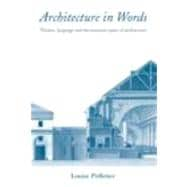
Note: Supplemental materials are not guaranteed with Rental or Used book purchases.
Purchase Benefits
What is included with this book?
| Illustration credits | ix | ||||
| Acknowledgments | xi | ||||
| Introduction | 1 | (8) | |||
| Part 1: Character and expression: staging an architectural theory | 9 | (48) | |||
|
11 | (14) | |||
|
17 | (4) | |||
|
21 | (4) | |||
|
25 | (21) | |||
|
26 | (4) | |||
|
30 | (10) | |||
|
40 | (6) | |||
|
46 | (11) | |||
|
47 | (3) | |||
|
50 | (7) | |||
| Part 2: Play-acting and the culture of entertainment: architecture as theatre | 57 | (48) | |||
|
59 | (18) | |||
|
62 | (2) | |||
|
64 | (3) | |||
|
67 | (6) | |||
|
73 | (4) | |||
|
77 | (28) | |||
|
78 | (4) | |||
|
82 | (13) | |||
|
95 | (10) | |||
| Part 3: Language and personal imagination: an architecture for the senses | 105 | (46) | |||
|
107 | (11) | |||
|
108 | (2) | |||
|
110 | (3) | |||
|
113 | (5) | |||
|
118 | (13) | |||
|
120 | (4) | |||
|
124 | (7) | |||
|
131 | (20) | |||
|
131 | (7) | |||
|
138 | (8) | |||
|
146 | (5) | |||
| Part 4: Plotting an architectural program: the space of desire | 151 | (41) | |||
|
155 | (14) | |||
|
155 | (6) | |||
|
161 | (8) | |||
|
169 | (23) | |||
|
170 | (13) | |||
|
183 | (9) | |||
| Conclusion: the temporality of human experience | 192 | (4) | |||
| Notes | 196 | (28) | |||
| Selected bibliography | 224 | (11) | |||
| Index | 235 |
The New copy of this book will include any supplemental materials advertised. Please check the title of the book to determine if it should include any access cards, study guides, lab manuals, CDs, etc.
The Used, Rental and eBook copies of this book are not guaranteed to include any supplemental materials. Typically, only the book itself is included. This is true even if the title states it includes any access cards, study guides, lab manuals, CDs, etc.